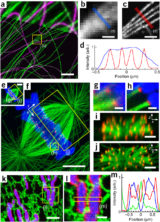Nikon Center of Excellence Opens in Nantes, France
May 19, 2016

Nikon is proud to announce that Nikon Instruments Europe/Nikon France recently opened a Center of Excellence in Nantes, France.



Follow Nikon Instruments for microscopy news and trends, updates on new products, and information on contests and promotions.
May 19, 2016

Nikon is proud to announce that Nikon Instruments Europe/Nikon France recently opened a Center of Excellence in Nantes, France.
May 16, 2016, via Nature Methods
There's a new review article in Nature Methods about the use of hydrogels as cell culture substrates. Typical cell culture plastics and glasses are rigid 2D substrates that poorly recreate in vivo conditions. Hydrogels are swell-able 3D polymer networks that mimic several important mechanical and chemical properties of soft tissues, with many varieties commercially available. The use hydrogels, and other recently developed biomaterials, increases the physiological relevance of cell cultures as model systems.
May 04, 2016, via NobelPrize.org

Nikon would like to extend condolences to the family and friends of Sir Harold Kroto, who passed away this past Saturday at the age of 76. Dr. Kroto was perhaps best known for the discovery of fullerenes, including 'buckyballs', for which he shared the 1996 Nobel Prize in Chemistry. He has previously served as a judge for our Small World competition. He will be sorely missed.
May 02, 2016, via Phys.org
Researchers at SMU will be spear-heading an effort by the Defense Advanced Research Projects Agency (DARPA) focused on developing advanced holographic techniques to image objects hidden from view - for example behind a wall, around the corner, or otherwise obstructed. DARPA wishes to develop the fundamental technologies needed to perform such indirect imaging in environments that strongly scatter light.
May 02, 2016

Michael Davidson was a brilliant scientist, artist and photographer. The creator of MicroscopyU, Davidson also authored many scientific articles on the subject of photomicrography. His photomicrographs were published in more than a thousand national and international scientific journals, popular magazines and newspapers. In addition, Davidson’s photomicrography won more than 40 awards in scientific and industrial photography competitions and has been exhibited at over 50 locations nationwide.
May 01, 2016
April 20, 2016, via www.nature.com
A new method for performing Fluorescence-Lifetime Imaging Microscopy (FLIM) using a single image. Instead of sequentially acquiring many images at different phases using an electronically modulated image intensifier, two images phase shifted by 180 degrees are recorded simultaneously on the same camera chip by directing photoelectrons to one of two holding areas, dependent on the phase of a digital clock signal. This new method will likely make live-cell time lapse FLIM imaging faster and more accurate by minimizing artifacts such as motion-induced blur.
April 18, 2016, via Nature Methods

Researchers at the University of Washington have demonstrated super-resolution Expansion Microscopy (ExM) using conventional antibody-bound synthetic dyes and fluorescent proteins (previous work used labeled DNA oligos). Their method works by linking fluorophores to a 'swellable' hydrogel using the cross-linking reagent methacrylic acid N-hydroxysuccinimidyl ester. Following protease digestion of the sample, the hydrogel polymer can be expanded by a factor of ~4 via dialysis, physically separating spatial features previously below the diffraction limit and yielding ~65 nm lateral resolution.
April 06, 2016, via Wiley Online Library
New graphene photodetectors have been introduced with strain-tunable photoresponsivity. 2D graphene sheets can be "crumpled" into a 3D structure, increasing the areal density and thus the effective absorbance cross-section. Structural parameters are adjusted by applying mechanical strain in the lateral directions. Furthermore, strain-tunable wavelength selection is demonstrated by integrating colloidal photonic crystals in the graphene layer.
March 30, 2016, via Nature Methods
New fluorescent protein-based sensors for detecting nitric oxide (NO), an important free radical and signaling molecule in many types of cancers. The fluorescent protein is fused to a well characterized bacterial NO binding domain. NO binding causes a conformational change bringing the moiety closer to the fluorescent protein chromophore, diminishing fluorescence. Importantly, fluorescence brightness scales linearly with NO concentration, allowing for absolute quantitation of NO levels. Microscopy equipment was provided by the Nikon Center of Excellence Graz.